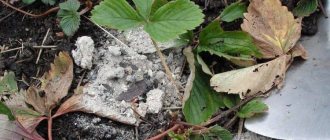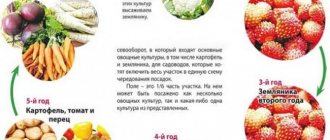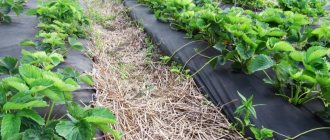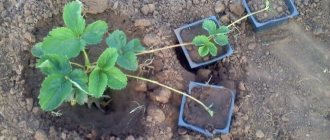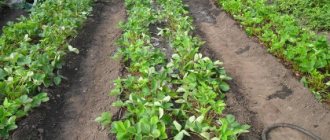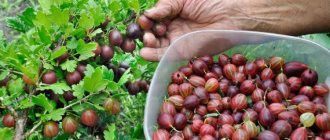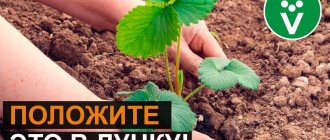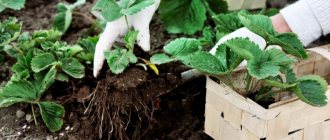Application in horticulture
Boric acid is a colorless and odorless substance with a crystalline structure that looks like scales. It is widely used in agriculture, in particular for growing fruit and berry crops, ornamental plants, as well as some root crops.
Reference! Boric acid is included in the group of harmful substances with the least harm to humans. Contact of acid on the skin will not cause negative effects, but it is still better to do the job with gloves.
This substance is used to enrich the soil, stimulate seed germination, and as an insecticide and fungicide. Boron plays a vital role in plant life, and its deficiency in the soil can lead to crop loss.
Feeding scheme during the season
The main ingredient for feeding can be purchased at a more than affordable price without a prescription at any pharmacy. But boric acid in its pure form (as powder) is not used for feeding strawberries. First you need to prepare a solution. Plants are treated with it by watering at the root or spraying the leaves. Foliar feeding is carried out only before flowering. The only exception is obvious symptoms of boron starvation - then you need to spray the substrate and the lowest leaves. If you neglect this rule, firstly, you will scare away bees and other pollinating insects, and secondly, you will provoke the deposition of excess boron in the berries, which is harmful to health.
Scattering boric acid in powder form over the garden bed will only harm the strawberry bushes.
Use only freshly prepared solution. First, boric acid is diluted in a small volume of hot water, then cool water is added so that the liquid temperature is 30–35ºС and the remaining ingredients are added. Watering or spraying is carried out in the morning or evening, when the sun is least active. About an hour before the procedure, the strawberries should be watered generously - this will reduce the risk of burning the roots. After it, watering is reduced to a minimum for 2-3 days.
Video: how to properly dilute boric acid for plant nutrition
During the growing season for strawberries, three fertilizing containing boron is enough:
- in the spring, before flowering, when the green mass is actively forming (some gardeners postpone it to the end of the season, feeding strawberries with boron about a month after the end of fruiting - in their opinion, bushes prepared in this way will overwinter better);
- at the moment the first buds appear, when they have not yet opened (the minimum interval between the first and second feeding is 10 days);
- about a week before harvest.
For foliar feeding of strawberries, 5 g of boric acid is dissolved in 10 liters of water. When the berry is grown on very light sandy or podzolic soils, its dosage can be increased by about 1.5 times.
In the vast majority of cases, spraying strawberries with solutions containing boric acid is carried out only at the beginning of the growing season.
If you want to water your plants in the spring, you can use the following recipes. One serving is enough to process approximately 20–30 bushes. The norms for adult and young plants when watering at the root are approximately 500 and 300 ml, respectively (for spraying - three times less).
For a bucket (10 l) of water you need to take:
- 1–2 g boric acid, 1 g potassium permanganate;
- a glass of sifted wood ash, 2 g of boric acid and potassium permanganate.
Before flowering, you can use the following solution options:
- a glass of ash, 30 drops of iodine, 3 g of boric acid;
- about 100 g of ash, a tablespoon of urea, 5 g of boric acid and 3 g of potassium permanganate.
When the berries ripen, complex fertilizers are most useful for strawberries. Dilute in 10 liters of warm water:
- about half a glass of sifted wood ash, 2 g of boric acid, 3 g of potassium permanganate, 10–15 g of fertilizer containing nitrogen;
- two tablespoons of ash, about 5 ml of iodine, 2 g of boric acid;
- a tablespoon of urea (or other nitrogen fertilizer), a liter of ash infusion, 2 g of potassium permanganate and boric acid.
Watering strawberries with a nutrient solution is carried out according to certain rules, which you need to familiarize yourself with in advance.
In order for fertilizing with boric acid to be as beneficial as possible, experienced gardeners recommend powdering the strawberry bushes and the soil in the garden bed with sifted wood ash immediately before the procedure (if it is not in the recipe). The nutrient solution will, as it were, “wash away” it deeper, allowing it to penetrate into the substrate rather than remain on the ground.
Video: personal experience and the result of fertilizing strawberries with boric acid
What is it used for when growing strawberries?
The presence of boron in the soil is very important for the normal growth of strawberries.
Boron helps synthesize nitrogen compounds necessary for the plant, has a beneficial effect on metabolic processes and helps increase the chlorophyll content in the foliage.
Strawberries planted in forest or soddy-podzolic soil need boron most of all. This type of fertilizer should also be used to enrich soil that is oversaturated with carbonates. Strawberries that grow in swampy or oxidized soil also need similar nutrition.
Signs of boron deficiency and excess
Boron deficiency is manifested by the following symptoms:
- Strawberry leaves begin to curl and die.
- Sometimes a symptom is deformation of the leaf plates, the appearance of a dry border along their edge. No matter how much you water these strawberries, they always look slightly wilted. If fertilizing containing boron is not applied in time, the leaves will continue to deteriorate. Eventually the entire plant may die. The roots will rot and the growing point will die.
- When the lack of boron is not so severe, its deficiency is noticeable in the formation of small ovaries. The number of berries in this case will be very small, and the taste of the fruit is unlikely to please. The strawberries will be watery and contain little sugar.
Excess boron, in turn, leads to impaired root growth, and the development of the vegetative part also slows down. On the leaves you can notice foci of necrosis in the form of yellow drying areas and reddish pinpoint burns.
Exceeding the content of the element is also dangerous because boron accumulates in the fruits and can cause poisoning after eating such berries.
For preventive purposes, strawberries are treated with boron in the spring before the flowers bloom and at the fruiting stage, when the berries become quite large. Boron deficiency is especially severe in sandy and calcareous soils, where it is washed out of the soil by water during irrigation.
Benefits of use
Proper use of this microfertilizer has a number of positive effects on the growth of strawberry plantations.
Adding such fertilizer to the soil will help increase the number of ovaries on the bushes.
Strawberries that do not lack boron will grow sweeter and tastier.
The presence of this substance in the soil is a good repellent against insects, in particular ants. Helps in the prevention of plant diseases such as dry and brown rot, bacteriosis. If the soil contains a sufficient amount of boron, then strawberries survive drought better.
The benefits of iodine when planting strawberries and during their flowering period
Before planting young rosettes in the ground, it is recommended to water it with iodine solution. The planting of strawberries itself can be done after 3 or 4 days. You need to fertilize strawberries using the following solution: dilute 3 drops of iodine in a ten-liter bucket of water.
Many people practice feeding strawberries before the flowering period. Fertilizer for this period will be different: dissolve 30 drops of iodine in a ten-liter bucket of water, and also add one teaspoon of boric acid and one cup of ash. Let the fertilizer sit for at least a couple of hours. Then mix the solution thoroughly. You need to fertilize the soil under the strawberry bushes. Each plant needs no more than 500 milliliters of solution.
You can improve this fertilizer for strawberries using laundry soap. The fact is that soap acts as a kind of connecting link, thanks to which iodine evaporates more slowly if you water the plant with it. In this case, the effect of the procedure for strawberries will be greater. After all, the drug will have time to have a positive effect on garden strawberries.
What are the signs of boron deficiency?
You can understand that a strawberry plantation is experiencing boron starvation by several signs.
First of all, you should take a closer look at the foliage. With little boron, the leaves become curved and their edges begin to die.
A plant starved of this element stops growing, the berries on it are smaller, as a result of which the overall yield of the strawberry plot is significantly reduced.
A lack of boron can also be determined by the taste of the berries: they become more watery, and the sweetness is not felt at all.
Terms and rules for using boric acid on crops
Boron included in the preparation is a sedentary microelement, and its concentration in plant tissues has a basipetal gradient. This means that if there is a deficiency of the component, the old leaves function, but the plants stop blooming and new shoots and leaves do not form.
On a note! In addition to boron, iron and calcium have the same properties.
The lack of the element is noticeable in the young parts of the plant; the buds and ovaries suffer more. Therefore, foliar spraying on the leaf is used, since in this case the substance will quickly reach those tissues and organs that need it.
Boric acid as a fertilizer for strawberries
It is customary to feed strawberries three times a year. Fertilizers are used when the growing season begins in the spring, during the autumn period when flowers appear, and also before preparing the plantation for winter.
Boric acid is especially relevant during the flowering period. Such fertilizer will increase the overall yield of the strawberry plot and will have a positive effect on the sweetness and size of future berries.
Important! During the flowering period, preference should be given to the root and subroot feeding methods.
Otherwise, acid may accumulate in the berries and cause harm to humans.
How can you tell if strawberries lack boron?
Also check out these articles
- How to plant carrots with seeds
- Feather removal machine
- Red Scarlet Potatoes
- Pruning roses
A lack of boron results in leaf curling and subsequent death. The leaves are simply deformed, they may not grow correctly, become distorted, or change shape. It is extremely important to feed strawberries with boric acid before the leaves just begin to deteriorate. When signs of necrosis of the above-ground part appear, the chance to save the crop becomes minimal.
If fertilizing is not carried out on time, this may threaten the plant's withering. But in addition, the ovaries will stop developing, small berries will form, and their number is very small and grow unevenly. These strawberries taste sour, watery, and contain little sugar.
Signs of boron deficiency in strawberries
It is very important to follow the dosage when preparing mixtures for feeding. If there is too much boron, it will simply burn the roots or leaves of the strawberry. The roots will develop slowly, just like the above-ground part.
The negative impact of the element can also affect humans. If you water the plant with it too often or do not know the proper concentration, it will accumulate in the berries. By consuming such a product, you can easily get inflammation of the mucous membranes and skin.
Boric acid as a method of pest control
This acid has antibacterial properties and is also useful as a disinfectant.
This makes this type of fertilizer a good option for pest control. Spraying with such acid will repel insects.
This is especially true for ants, which can spread aphids throughout the area with strawberries. Also, this method of prevention will help get rid of unwanted fungal growths and some types of rot.
Processing berries using potassium permanganate
Manganese is a well-known substance that has found application in various sectors of human activity, and especially in gardening. In particular, potassium permanganate for strawberries is not only an excellent preventive and antiseptic agent, but also the main weapon in the fight against diseases and pests, as well as an excellent fertilizer. Strawberries respond well to foliar feeding.
You need to fertilize the soil in stages. The first time you need to process young leaves. The best time for this is early spring. Spring feeding also involves applying the drug during the flowering period of strawberries. Watering strawberries should be done with manganese. When foliar spraying, try not to touch the inside of the leaf.
Potassium permanganate has truly universal properties regarding strawberries. Firstly, you can soak the seeds in it before planting them in open ground. To do this, you need to dilute potassium permanganate with water in a proportion of 0.5 grams of the substance per 100 milliliters of liquid. This will help rid the strawberries of bacteria that spend winter on the seeds and, during planting in the spring, stimulate the appearance of various diseases. How long to keep seeds in potassium permanganate? Approximately 20 minutes. Immediately after this, the seeds are thoroughly dried.
Gardeners also willingly share the secret of preparing fertilizer for strawberries for application in early spring. Mix potassium permanganate in a ratio of 3 grams of fertilizer per ten liters of water and supplement it with a pinch of boric acid. This feeding is especially suitable in early spring for areas with sandy soil. In order to save strawberries from gray rot, you need to treat them with the following fertilizer: stir two teaspoons of potassium permanganate (without a slide) in ten liters of water. It is recommended to spray strawberries with the preparation in the spring - after the end of the flowering period. However, you should not spray strawberries with potassium permanganate too often. After all, an excess of the substance in the soil can have a bad effect on the development of strawberries in the spring.
Don’t forget that manganese is an excellent treatment for gardening tools, as well as seedling boxes, greenhouses and greenhouses.
How to prepare the solution?
There are many boron-containing gardening preparations that you can buy and prepare a solution according to the instructions. However, there are also recipes in which you can make the solution yourself by purchasing the main ingredient at the pharmacy.
Important! To prepare all types of solutions with this substance, you should use only warm water. After the required volume can be achieved by adding cool water.
Mixture with iodine
Boric acid and iodine are well suited for feeding strawberries in the spring.
To prepare the solution you will need 10 g of acid, 200 g of ash, and 30 drops of iodine. All this is dissolved in ten liters of water.
After preparation, the solution is applied to the plants by spraying. This must be done before the buds bloom.
With potassium permanganate
To prepare such a solution, you will need 100 g of ash and 20 g of urea. This should be placed in a ten-liter container with water, adding 5 g of acid and 3 g of potassium permanganate. Once all the ingredients have dissolved, the product is ready for use.
Timing of fertilizing
Boric acid is fed to strawberries not simply by scattering the substance in dry form over the surface of the ground, but by adding liquid solutions. Nutrient mixtures are prepared according to certain recipes, which differ depending on the method and time of use. You can feed garden strawberries with boric acid either foliar or at the root.
Foliar feeding is the application of fertilizers by spraying plants, i.e., on the leaf.
Foliar feeding of strawberries with boric acid is carried out before flowering
Boron is added as follows:
- The substance is used for the first time in the spring when the snow melts, thereby ensuring the maintenance of normal levels of nutrients in plants after winter. The crop is fed at the root or on top of snow and plants.
- Foliar feeding is carried out only before flowering. During the flowering period, such treatments are not recommended, as they will harm pollinating insects. Spraying with a weak solution of boric acid can be done during the formation of flower buds.
- The third feeding occurs during the ripening period of the berries. It is performed at the root using a low concentration solution. Even a small amount of the substance will be enough for plants.
Other recipes
In addition to potassium permanganate and iodine, boric acid is often combined with other substances.
For example, a mixture of boric acid and nitrogen-phosphorus-potassium fertilizer makes strawberries less watery and increases their sugar content.
A mixture of boric acid and potassium salt is an effective preventative against fungal diseases. To prepare such a solution, a couple of grams of salt and acid are dissolved in ten liters of water.
A solution with boric acid and superphosphate will help avoid the death of fruits and the appearance of cracks on them. 2 g of acid are diluted in ten liters of water, after which 10 g of simple or double superphosphate are added. This product also helps increase productivity.
Rules for feeding and treating strawberries with iodine against diseases and pests: recipes for solutions
Treatment of strawberries with iodine begins in the spring, when new foliage begins to grow and flower stalks appear from the centers. A repeated procedure is carried out at the stage of bud formation, and the third and final procedure is carried out after the berries are completely harvested. During the period of growth and fruit filling, iodine supplementation is not used. But you can use it when planting rosettes in early spring. In this case, you need to spill the iodine solution on the soil a day before to disinfect it.
To water strawberries with iodine, prepare a simple solution of 10 drops of tincture in a bucket of water. The liquid should be used immediately after preparation, as iodine quickly evaporates from it. Before you start processing strawberries, you need to put on a respirator so as not to breathe toxic fumes. For foliar spraying before flowering, prepare a less concentrated liquid of 5 drops of tincture per bucket. Add 1 tbsp to it. l. liquid soap for adhesion. To enhance the effect, 1/10 of the water can be replaced with whey, which also has the ability to destroy pathogens.
We recommend reading
How to care for strawberries in spring, advice from experienced gardeners
How can you feed strawberries in the spring to get a good harvest?
Fertilizing strawberries during flowering and fruiting
Features of caring for strawberries to obtain a bountiful harvest
Dosage and correct use for strawberries
All plants need boron constantly, at all stages of the growing season. All garden crops are conventionally divided into three groups, according to the amount of their need for boron.
Strawberries belong to the group of plants that least need this element. Therefore, you need to be careful so that when using boric acid you do not cause an overdose and destroy the plantation.
When feeding strawberries with the mixture, you should avoid getting the solution on the berries and flowers. These types of fertilizers are best applied to moist soil - after precipitation or watering. This should be done during the day, in the light of the sun.
Pay attention! Strawberries are most inclined to accept such fertilizers when flowering begins. Increasing the boron content will significantly improve the quality and quantity of berries.
To treat strawberry seeds with a boric acid solution, you need to take a rag bag, place the seeds there, and put it in the solution for 24 hours. The solution in this case should be light - a maximum of two grams of boric acid per 10 liters of water.
How often and at what time to treat strawberries with boric acid
Since boron is important for fruit formation, treatments are carried out twice:
- as soon as the buds began to open;
You need to have time to fertilize strawberries with boric acid before the flowers bloom
- when the berries set.
If the bushes show pronounced signs of boron starvation (see above), you can water the strawberries under the roots from a watering can (or better yet, between the rows), trying to prevent the solution from getting on the leaves and flowers.
Errors
Some gardeners use acid in the wrong way. By doing this, they harm the growth of the crop or its quality. Common mistakes include applying the solution to already opened flowers and to the berries of the plant.
This causes acid to accumulate in the berries, causing kidney disease after consumption. Enriching soil with boron, which already has enough of this element, is also a serious drawback. When using acid as insect bait, the dose is often exceeded. After this, the ant quickly dies right next to the plant, not having time to spread the poison throughout the anthill.
Why do garden strawberries need iodine and boric acid?
Both products have been used by vegetable growers for a long time, as they give a noticeable effect. Both boric acid and iodine have a positive effect on plants, are inexpensive and always available.
The benefits and harms of iodine
Iodine solution is used during the budding period. Despite the fact that it has not been established that this element is vital for plants, vegetable growers, after using a solution of pharmaceutical tincture, note increased growth, strengthened immunity and an increase in yield, both this and next year.
Iodine is not only a fertilizer; it is used to destroy bacteria, fungal spores and repel weevils, destroy aphids, beetle larvae and caterpillars. For the prevention and treatment of bushes, iodine is added along with water when watering at the root and spraying on the leaves.
You can talk about the dangers of iodine for strawberries if you use it by increasing the dosage or more often than expected. The element must be supplied to plants in a minimum amount; if there is an excess, it will accumulate in tissues. To prevent this from happening, it is recommended to use industrial complex fertilizers, in which iodine is already in an assimilable form and in the required quantity.
The benefits and harms of boron
It is necessary for the growth of green parts of bushes, improves the processes of photosynthesis and the absorption of calcium, increases the production of chlorophyll, accelerates the metabolism of carbohydrates, and increases the level of plant resistance to all types of diseases: fungal, viral and bacterial.
Boric acid is used throughout the season, but it is especially useful for flowering strawberries: boron stimulates lush flowering, prevents flowers from falling off, increases the number of fruits set, which ultimately has a good effect on yield. It also improves the taste characteristics of the berries.
In addition, it is necessary to use boric acid as a fertilizer if there are signs of a deficiency of this element - strawberry leaves take on an irregular shape, become thin and brittle, and root growth stops.
Boron may be harmful to strawberries if it is overdosed. This can also be seen in the leaves: they become weak and turn yellow. In order not to harm the plants, when preparing the solution you must strictly adhere to the recommended concentration.
Fertilizing strawberries for a large harvest in spring, summer and autumn
Chernozem soil is ideal for growing strawberries - it is loose, fertile, and on such soil the yields of this berry crop will always be high. However, not many summer cottages can boast of such soil.
Therefore, you have to add fertilizers to the soil before planting strawberry seedlings, and also feed this berry crop throughout the spring-summer season in order to get a high yield of fruits from your strawberry plantation.
This article will discuss when and what fertilizers to apply to strawberries.
10.Root feeding
Spring root feeding can be done after the snow has melted, but only in dry weather. For this feeding, you need to dissolve about 2 grams of boric acid and 0.5 grams of potassium permanganate in 10 liters of warm water, stirring thoroughly. This mixture can be used immediately after preparation and is enough for about 40 strawberry bushes.
Root feeding using ash will also be useful: one glass of wood ash, 2 grams of boron and 1 gram of potassium permanganate are dissolved in a bucket of warm water. After preparation, this solution is used immediately.
External signs of excess boron
Each plant crop reacts differently to an excess of boric acid. The following pathological processes have been observed in strawberries:
- slow formation of new roots;
- absence of ovary;
- deformation of sheet plates. They acquire an irregular dome-shaped shape;
- Numerous blue or purple dots appear along the edges of the leaves;
- loss of ovary.
Fertilizing strawberries with mineral fertilizers
This berry crop can be fed with the following types of mineral fertilizers:
- Complex mineral fertilizer, which should include potassium, phosphorus, nitrogen, magnesium. These minerals are absorbed by plants in the shortest possible time;
low mobility composition - it contains boron, iron, manganese, copper. All these elements are absorbed more slowly by the roots and leaves of strawberries.
After the flowers appear, fertilizers containing large amounts of potassium are applied to the bushes. It is best to apply potassium magnesia or potassium sulfate to the plants.
Mineral fertilizers with sulfur are applied to this berry crop in order to increase their immunity against diseases and pests.
Phosphorus is necessary for the strawberry root system to develop; the best preparations in this case are superphosphate and ammophosphate.
6.Precautions when working with boric acid
Boric acid belongs to the group of general cellular toxic drugs and can cause poisoning. In this regard, when working with the drug, the following precautions must be observed:
- Work with acid in overalls and gloves;
- Use a respirator to protect your respiratory system;
- Work in a well-ventilated area;
- After completing work with boric acid, observe personal hygiene rules.
It is important to note that boric acid is highly flammable, so it should be stored away from fire. After using the drug, close the package well and store in a dark and cool place. Boron-containing fertilizers lose their effectiveness if stored at -1°C.
A respirator and gloves are required when working with boric acid.
How to fertilize strawberries when planting?
Strawberries are transplanted in spring or autumn - it depends on the period of the year what to fertilize strawberries with when planting.
In both cases, you need to start by preparing the beds in the garden, for which you should prepare the soil mixture in the following proportions: for 10-12 liters of soil, take the same amount of compost or humus, 2 cups of ash, 30 g of superphosphate. The resulting substrate is laid out on a layer of sand and seedlings are planted in it.
When planting, you should add growth stimulants for strawberries. This can be a nitrogen mixture - ammonium nitrate plus ammophos in a ratio of 1:2. A solution for watering the soil is prepared from it, consumption is 15 g per 1 sq. m.
The use of urea to feed strawberries during planting is prohibited: it can damage fragile roots. Overfeeding with organic matter should also be avoided.
Fertilizers for strawberries when planting in the spring are intended to give impetus to the development of green mass, and in the fall - to prepare them for wintering, when active growth is extremely undesirable.
3. Under what conditions does boron deficiency occur in strawberries?
Boron starvation in strawberries can occur as a result of the lack of timely application of boron-containing fertilizers. Boron deficiency most often occurs when strawberries are grown during the rainiest seasons. Thus, large amounts of precipitation contribute to the leaching of boron and other microelements from the soil.
The amount of boron decreases after the liming procedure. The previous crop can reduce a significant amount of boron. The boron content in the soil depends on its mechanical structure. In the table we consider several types of soils with low boron content:
| Soil types | Causes of Low Boron Content |
| Sandy | The decrease in boron occurs due to strong leaching by precipitation. |
| Alkaline | An increase in humus and clay particles reduces the mobility of microelements. |
| Podzolic | Most of the boron is in inaccessible form and is easily washed out of the soil. |
11.Anti weevil
It is important to treat the plant before flowering, otherwise it will not be saved later. Prepare the solution as follows: take 30 drops of birch tar, 15 drops of iodine, 1.5 grams of boric acid and 3 cups of green infusion into a bucket of water. After this, mix the mixture thoroughly and add a glass of solution to a ten-liter bucket. Thoroughly spray the plants with a spray bottle.
After such a procedure, the berries will not only shine with beauty and health, but will also get rid of pests.
Pest protection
Experienced gardeners use boric acid, ammonia, and hydrogen peroxide to protect crops from pests. According to reviews from summer residents, the solutions help prevent the appearance of aphids and weevils, and expel ants from Victoria beds.
- prophylactic solution for spraying: 2 g of acid powder is diluted in 10 liters of water;
- mix 2 g of the drug, a teaspoon of iodine in a small amount of warm water, add a couple of spoons of tar, ammonia (an aqueous solution of ammonia), a teaspoon of fir oil. Add liquid to a volume of 10 liters and mix. Dilute the concentrated composition with water 1:20, water the strawberry beds.
To exterminate ants, baits with boron powder are prepared:
- a glass of granulated sugar is mixed with 2 g of acid, a teaspoon of honey, 2 tablespoons of glycerin, and a little water are added. Balls are made from the resulting mixture and laid out between the rows;
- mix two boiled egg yolks, 1 g of boric acid. The mixture is rolled into small balls and the ants are “treated” by placing the bait near the insect trails.
Getting a high yield of your favorite berries is not so easy; you need to know many different garden “secrets” and “tricks”. By using boric acid on strawberries, you can quickly solve problems with plant nutrition, prevention and protection of the crop from infections and some pests.
Success in growing this berry crop and obtaining a good harvest directly depend on how to fertilize strawberries, when to carry out these activities and what nutrients to use.

